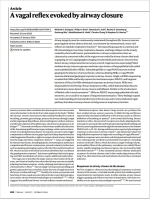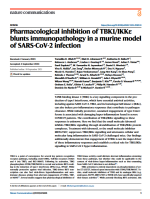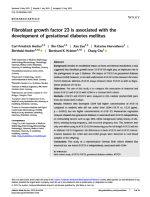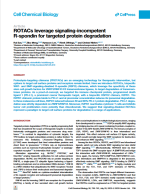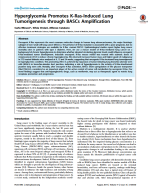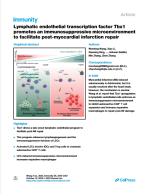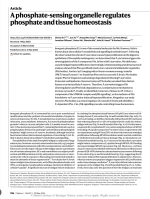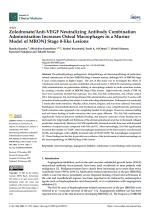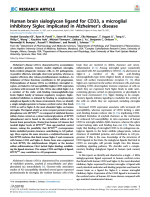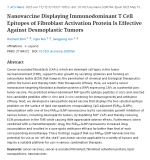24.07.2024
A vagal reflex evoked by airway closure Nature, 2024
Researchers discovered a specific vagal pathway that detects airway closure, helping to preserve breathing function. Schappe MS, et al. A vagal reflex evoked by airway closure. Nature. 2024 Mar;627(8005):830-838. Epub 2024 Mar 6. PMID:
01.12.2023
Pharmacological inhibition of TBK1/IKKε blunts immunopathology in a mu... Nature Communications, 2023
Abstract TANK-binding kinase 1 (TBK1) is a key signalling component in the production of type-I interferons, which have essential antiviral activities, including against SARS-CoV-2. TBK1, and its homologue IκB kinase-ε (IKKε), can also induce pro-inflammatory responses that contribute to pathogen clearance. While initially protective, sustained engagement of type-I interferons is associated with damaging hyper-inflammation found in severe COVID-19 patients. The contribution of TBK1/IKKε signalling to these res...
10.11.2023
Fibroblast growth factor 23 is associated with the development of gest... Diabetes/Metabolism Research and Reviews, 2023
Abstract Background: Besides its established impact on bone and mineral metabolism, it was suggested that fibroblast growth factor 23 (FGF23) might play an important role in the pathogenesis of type 2 diabetes. The impact of FGF23 on gestational diabetes mellitus (GDM), however, is not well understood. iFGF23 ELISAs measure the intact FGF23 molecule, whereas cFGF23 assays measure intact FGF23 as well as degradation products of FGF23. Objectives: The aim of this study is...
03.11.2023
ROTACs leverage signaling-incompetent R-spondin for targeted protein d... Cell Chemical Biology, 2023
Abstract Proteolysis-targeting chimeras (PROTACs) are an emerging technology for therapeutic intervention, but options to target cell surface proteins and receptors remain limited. Here we introduce ROTACs, bispecific WNT- and BMP-signaling-disabled R-spondin (RSPO) chimeras, which leverage the specificity of these stem cell growth factors for ZNRF3/RNF43 E3 transmembrane ligases, to target degradation of transmembrane proteins. As a proof-of-concept, we targeted the immune checkpoint protein, programmed death ligand 1 (PD-L1), a prominent...
30.10.2023
Hyperglycemia Promotes K-Ras-Induced Lung Tumorigenesis through BASCs... PLOS ONE, 2014
Oncogenic K-Ras represents the most common molecular change in human lung adenocarcinomas, the major histologic subtype of non–small cell lung cancer (NSCLC). The presence of K-Ras mutation is associated with a poor prognosis, but no effective treatment strategies are available for K-Ras -mutant NSCLC. Epidemiological studies report higher lung cancer mortality rates in patients with type 2 diabetes. Here, we use a mouse model of K-Ras-mediated lung cancer on a background of chronic hyperglycemia to determine whether elevated circulating glycemi...
20.10.2023
Lymphatic endothelial transcription factor Tbx1 promotes an immunosupp... Lymphatic endothelial transcription factor Tbx1 promotes an immunosupp...
Abstract The heart is an autoimmune-prone organ. It is crucial for the heart to keep injury-induced autoimmunity in check to avoid autoimmune-mediated inflammatory disease. However, little is known about how injury-induced autoimmunity is constrained in hearts. Here, we reveal an unknown intramyocardial immunosuppressive program driven by Tbx1, a DiGeorge syndrome disease gene that encodes a T-box transcription factor (TF). We found induced profound lymphangiogenic and immunomodulatory gene expression changes in lymphatic endothelial cells...
29.09.2023
A phosphate-sensing organelle regulates phosphate and tissue homeostas... A phosphate-sensing organelle regulates phosphate and tissue homeostas...
Abstract Inorganic phosphate (Pi) is one of the essential molecules for life. However, little is known about intracellular Pi metabolism and signalling in animal tissues. Following the observation that chronic Pi starvation causes hyperproliferation in the digestive epithelium of Drosophila melanogaster, we determined that Pi starvation triggers the downregulation of the Pi transporter PXo. In line with Pi starvation, PXo deficiency caused midgut hyperproliferation. Interestingly, immunostaining and ultrastructural analyses showed that PXo...
22.09.2023
Zoledronate/Anti-VEGF Neutralizing Antibody Combination Administration... Journal of Clinical Medicine
Abstract The pathophysiology, pathogenesis, histopathology, and immunopathology of medication-related osteonecrosis of the jaw (MRONJ) Stage 0 remain unclear, although 50% of MRONJ Stage 0 cases could progress to higher stages. The aim of this study was to investigate the effects of zoledronate (Zol) and anti-vascular endothelial cell growth factor A (VEGFA) neutralizing antibody (Vab) administration on polarization shifting of macrophage subsets in tooth extraction sockets by creating a murine model of MRONJ Stage 0-like lesions. Eight-we...
28.07.2023
Human brain sialoglycan ligand for CD33, a microglial inhibitory Sigle... Human brain sialoglycan ligand for CD33, a microglial inhibitory Sigle...
Abstract Alzheimer's disease (AD) is characterized by accumulation of misfolded proteins. Genetic studies implicate microglia, brain-resident phagocytic immune cells, in AD pathogenesis. As positive effectors, microglia clear toxic proteins, whereas as negative effectors, they release proinflammatory mediators. An imbalance of these functions contributes to AD progression. Polymorphisms of human CD33, an inhibitory microglial receptor, are linked to AD susceptibility; higher CD33 expression correlates with increased AD risk. CD33, also...
21.07.2023
Nanovaccine Displaying Immunodominant T Cell Epitopes of Fibroblast Ac... ACS Nano, 2023
Abstract Cancer-associated fibroblasts (CAFs), which are dominant cell types in the tumor microenvironment (TME), support tumor growth by secreting cytokines and forming an extracellular matrix (ECM) that hampers the penetration of chemical and biological therapeutics within the tumor and thereby limits their therapeutic efficacy. Here, we report a cancer nanovaccine targeting fibroblast activation protein α (FAP)-expressing CAFs as a potential pan-tumor vaccine. We predicted immunodominant FAP-specific epitope peptides in silico and...



